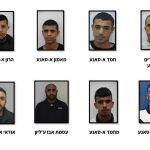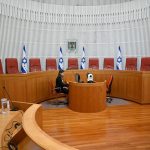Rising Crime Fuels Migration of Israeli Arabs to Jewish Cities
Jerusalem, 7 September, 2023 (TPS) -- Israeli Arabs are increasingly moving to Jewish cities to escape the rising crime wave in their own communities. But a lack of infrastructure for shared living between Arabs and Jews in certain neighborhoods threatens to exacerbate social tensions.
Many Israeli Arab public officials contacted by the Tazpit Press Service did not want to be quoted by name, saying they are afraid to comment on the current crime wave.
“The Arab elite is fleeing en masse,” one official from the Haifa area told TPS. “Those who can leave the villages and cities, do not hesitate to move to the Jewish settlements.”
Another Arab official told TPS that organized crime has permeated so many levels of life in Arab localities.
“Crime families and criminals have infiltrated all areas of life and, among other things, they take over tenders in municipalities, pressure the heads of councils and municipalities to approve illegal construction, force school principals to hire dozens of women as teachers even though they have not undergone any training and this in order.”
According to the Abraham Initiative, a Jewish-Arab organization which promotes Arab integration into Israel society, 169 Arab Israelis have been killed in criminal violence since the beginning of 2023. This year’s spike in violence is attributed to organized crime groups fighting turf battles and trying to eliminate rivals. Arab criminal organizations have been involved in extortion, money laundering, trafficking in weapons, drugs and women.
“Already today you can see hundreds of Arab women in the gyms in the Jewish communities, families who come to community centers in Jewish communities and thousands who buy houses in the communities, mainly in the Galilee,” the official told TPS. “On the streets of Haifa and its suburbs, you can already see Arab women and men going for morning or evening runs, which are not acceptable in a large part of the Arab settlements.”
The phenomenon shows in localities across the country.
Haifa, which is emerging as a major hub for Arab residents, has earned the nickname, “the Tel Aviv of Arab society.”
“There is positive immigration also as a result of the state of the Arab settlements,” he said, “Haifa is a center of cultural activity with a secular character and it attracts quite a few young people and you can say that Haifa is the Tel Aviv of Arab society.”
In the north, Arabs are relocating to towns like Kiryat Shemona, Karmiel, Maalot, Acre, Atlit, Beit Shean and areas around Nazareth. TPS has learned that the Higher Arab Monitoring Committee, an umbrella organization of Israeli Arab municipal leaders, has already classified the Galilee region as a mixed region due to this migration.
Others Arabs are moving Beer Sheva, which is often referred to as the “Capital of the Negev,” and western Jerusalem.
A review of various publications about the phenomenon shows that contractors in the northern Israel — particularly Haifa, Karmiel, Acre, and Maalot — report that increasing numbers of Arab families are purchasing homes in Jewish neighborhoods. While some attribute this to better schools and quality of life, Arab officials stressed that the surge in Arab crime is accelerating this trend.
The migration of Arabs to Jewish settlements is not new. But until crime became an accelerating factor, Arabs moving into Jewish neighborhoods tended to be more educated and seeking a more liberal lifestyle.
“This is clear, you are right,” an Islamic Movement official acknowledged to TPS. “But the fear of harming innocents and children, as we have seen in recent months, increases this phenomenon which, until today, has developed out of the search for better housing conditions and quality of life and is now receiving a huge boost due to crime in the Arab sector.”
TPS has also learned that fears of crime have driven dozens of Arab families to even leave Israel.
Challenging Coexistence?
These shifts are not without challenges. During the Gaza war of May 2021, Arab residents of several mixed cities — including Acre, Lod, Jaffa and Ramle — rioted, killing three Jews and injuring around 600 more. Jewish homes, cars and synagogues were torched, raising difficult questions about Jewish-Arab coexistence that still linger.
But Sheikh Kamal Rayan, one of the few Arab leaders willing to speak openly, told TPS that the Arab migration reflects nothing more than a desire for a safety and better living standards
A member of the Islamic movement, Rayan previously served as the head of the Kfar Bara municipal council and the deputy director of the local government center. After the murder of his son, Maaz, in 2009, Rayan and his wife founded the Aman Center, which deals with crime in society Arabic and he dedicates his life to the subject.
Arab citizens would prefer to remain in their communities, “but the intensification of crime and the massacres that occur in the Arab settlements push a large part, especially the elites of the Arab society, to move to the nearby Jewish settlements,” Rayan told TPS.
According to Aman data, the number of Arab murders in 2018 was 38 murders per million people, while in Jewish society this number was only six. By the middle of 2023, the number of Arab murders was 115 per million people, while the number of Jews was only four.
Rayan accused the Israeli government for not taking stronger measures against Arab crime families, which he said inadvertently encouraged the migration.
“Whoever examines the curve of the increase in crime and massacres in Arab society compared to the decrease in crime in Jewish society will be able to understand the motive for this immigration,” Rayan told TPS. “The gap in the number of murders between the two populations is the largest in the world among countries where there is more than one nationality. The number of murders per capita in Arab society in 2023 is 30 times greater than that in Jewish society.”
The figures indicate that the Israeli state “underestimates the value of life in Arab society and worries about the value of life in Jewish society,” he argued.
Several Arabs told TPS that the development of mixed neighborhoods may generate greater social sensitivity, especially during Jewish, Muslim and Christian holidays. Several pointed to Haifa, a mixed city of Jews, Christians and Muslims that has been a symbol of coexistence for years.
“Imagine Ramadan in a Jewish neighborhood where hundreds of Arabs live,” one Arab public figure told TPS. “It is clear that Jews will want to preserve the beauty of the neighborhood or the community, and what about the cultural life of the Arab immigrants?” he asked.
But one Haifa Jewish activist, Asher Takatash a Likud lawyer described the migration as a “silent occupation,” aimed at incrementally claiming Jewish land.
“This is not a matter of chance, but of a pre-planned act that I call the ‘quiet occupation.’ Jewishness in order to break the balance and division that has prevailed in the city for years,” Takatash told TPS.
Israel officially defines a mixed city as a municipality where at least 10% of the population are minorities. Only seven localities have that designation: Tel Aviv-Jaffa, Haifa, Acre, Ramla, Lod, Nazareth Illit and Maalot Tarshiha.
Jerusalem is treated differently because of thousands of non-citizen Palestinians live in eastern Jerusalem with temporary residence permits.
But 2009 study conducted at the initiative of the Abraham Foundation defined a mixed city as having 50,000 Arab residents, which would add Beer Sheva and Karmiel to the list, and now possibly, Beit Shean, Atlit, Nof HaGalil and Kiryat Shemona as well.
Cities designated as “mixed” by the Interior Ministry receive additional funding for infrastructure, such as schools, hospitals and community centers.
What this migration means for Jewish-Arab relations, Israeli demographics and budget allocations remains to be seen.







